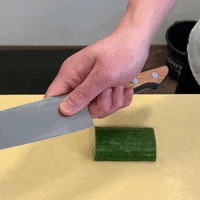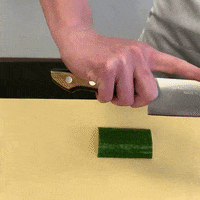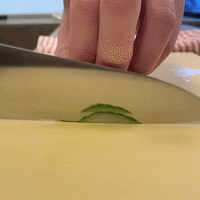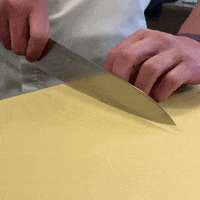Please note: In the busy month of December, PostNL is experiencing increased volume. As a result, the delivery of your package may take longer than usual.
- Knives
- Tools
- Engraving
- Giftcards
- Book
- Sharpening Box
- Shop
- Workshop
- Info
Your cart is currently empty
Knife skills can be one of the most intimidating obstacles when learning to cook.
You see your favorite chef on TV chopping up vegetables blindfolded... Super cool to see, but not a skill fore beginners... As a beginner you need a good foundation and then you are well on your way to become a good chef. This for instance, a good base of cutting techniques ensures that your beautiful knife remains sharp and will not be damaged while cutting. A good basic technique also ensures that you do not injure yourself, cut your finger off and never touch a sharp knife again.
Super cool to see, but not a skill fore beginners... As a beginner you need a good foundation and then you are well on your way to become a good chef. This for instance, a good base of cutting techniques ensures that your beautiful knife remains sharp and will not be damaged while cutting. A good basic technique also ensures that you do not injure yourself, cut your finger off and never touch a sharp knife again.
In this article, we're going to take you through the basic techniques you'll need: Position, how to hold a knife, how to hold the ingredients, and the basic cutting motion. Better techniques will make you a better chef.
Step 1
Preparation
- Provide a clean work table with a cutting board which is non slipping and a clean cloth
- A sharp knife, if you need one: www.hamono.nl
- Something to cut.
If you are not cutting, store the knife with the cutting edge away from you.
Step 2
What is my position?
- Position, right in front of your cutting board
- Body at an angle of 45 degrees
- Foot position
Step 3
How to hold my knife?
There are different ways to hold a knife, depending on the product you are cutting and which knife you are using.
- Pinch grip
Probably the most famous way to hold a Japanese knife. You use this 90% of the cutting.
Put 3 fingers around the handle and slide the middle finger towards the heel of the knife. Squeeze the blade with your thumb and forefinger. 
- Point grip
Basically the same as the pinch grip, but now the index finger moves to the top of the blade. It provides more control when cutting delicate products. You will often see a sushi chef use this grip when cutting sashimi. This grip is also good for longer knives.
Step 4
How should I position my hand that holds the ingredients?
Let's say you cut a cucumber:
- Make sure the cucumber has been cut to a manageable size first. Have a flat piece at the bottom so that it does not roll away
- Turn your fingers inward, make a kind of open fist
- The first knuckle of your index finger serves as a guide for contact with the blade of the knife.
It also ensures that you don't lift your knife too high.
Depends on what you cut, but your thumb pushes the ingredient to stabilize it. 
Step 5
Push cutting or pull cutting?
- Push cutting
Most commonly used in the Japanese kitchen. Especially with basic ingredients such as cutting vegetables. The Japanese knives have a slightly flatter cutting surface and are therefore extremely suitable for this movement. Place the cutting edge on the center of the ingredient and at the same time make a pushing movement forwards and downwards with the knife: 
- Pull cutting:
Pull cutting is mainly used for cutting raw fish. Basically the opposite of pushing. Place the blade by the heel on the product and make a long pulling movement towards you. Finish at the tip of the knife. 
Conclusion:
That's it, now you have a solid foundation! Time to practice and pay attention to safety! Use a sharp knife! This makes cutting so much easier. You need to use less force and the knife will do exactly what you want.
Good luck!
Source: The Chef Dojo